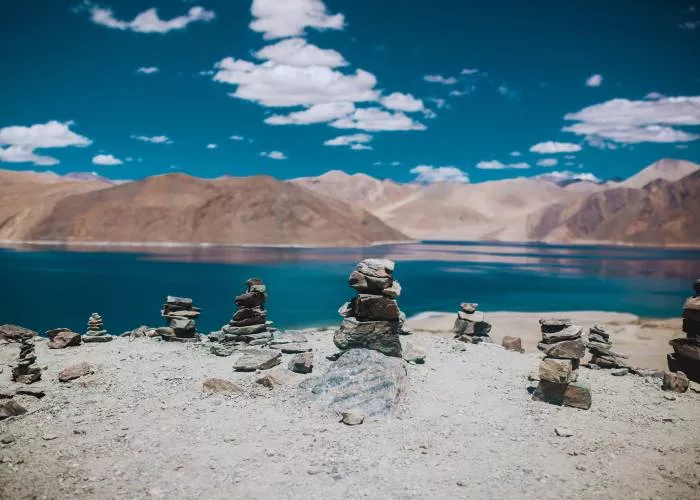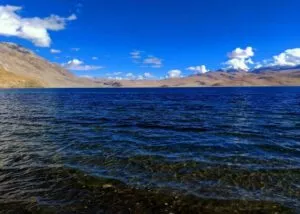About CHORTEN: Interesting Facts of This Tourist Attractions in Ladakh
Ladakh is adorned with Stupas and chorten which can be found at every mile in Ladakh. Have you ever thought about how they came to be? Why were they constructed? We all have an idea of what it represents, but do you want to know more? Let’s go a step further to know more about this tourist attraction in ladakh.
The word chorten meaning “an object or support of worship or offering.” It can be any holy object that may differ in shapes, sizes, and purposes. It is a translation of the Sanskrit terms stupa and caitya. Often used to mark cols (mountain passes), these structures are frequently seen as monuments in leh ladakh tour packages. Where some are seen strung with prayer flags and some have mani stones placed nearby. These iconic Buddhist structures are even found at some of the most remote leh ladakh places to visit and also be seen all over Asia. Symbolizing the presence of Buddha tourist attraction in ladakh location/spot.
“Did you know, the earliest Buddhist chortens are said to have been built during the life of the Buddha as monuments containing the remains of the enlightened saints who passed into nirvana.
Despite their sometimes worn-down appearance, these small mountain chortens serve the same purpose as those found at the start of Mera Peak treks in places like Kathmandu. They serve as a religious focal point in the landscape and are thought to have a positive impact on those who live nearby or pass through. As a result, many hikers and riders from leh ladakh bike tour, come across the remains of small offerings made by passing traders and pilgrims.
WHAT EXACTLY IS CHORTEN/ STUPA?
A Chorten or Stupa is derived from the original stupas of India that housed the Buddha’s relics; today, some contain important artifacts, but all hold offerings and prayers. It represents the Buddha’s mind, and each section of the Stupa depicts the path to Enlightenment. As a crucial part of leh tourism and india, it is believed that during the Namgyal dynasty, the punishment for the convicted was the construction of a Stupa. As retribution for their wrongdoing.
“Constructing a chorten is considered an act of karma that contributes to rebirths.”
The offerings are fixed inside the chortens during the construction process. Mantras written on paper, jewelry, and other precious objects are examples of offerings; however, it is more important to simply make an offering than to ensure the item is expensive tourist attraction in ladakh.
ORIGIN STORY OF CHORTEN
The stupa is the most ancient Buddhist religious structure. Stupas were simply earthen and stone mounds used to bury important kings away from the village in prehistoric times. Stupas were viewed differently twenty-five hundred years ago, at the time of Shakyamuni Buddha’s death.
The Buddha requested that his relics be housed in a familiar stupa, but with a twist. The Buddha’s remains are said to have been divided into eight parts and enshrined in eight chortens located throughout north India. The eight major events in the Buddha’s life, from birth to death, are also commemorated by eight different types of chortens, which are now known as Desheg Chorten Gye or Eight Stūpas of the Buddha.
Instead of simply being a place of honor for the cremated king’s bones or relics, these stupas reminded people of their awakened state of mind. As a result, it evolved from a king’s burial tomb, to a religious monument.
“Stupas are a reminder to the people that they can follow the path of enlightenment at any age of their lifetime.”
THE ANATOMY OF CHORTEN
The Stupa’s design depicts Buddha wearing a crown and seated in a meditation posture on a lion throne. The crown is represented by the spire’s top, which features the well-known “twin-symbol” uniting the sun and moon, the square at the spire’s base represents his head, the vase shape represents his body, the steps (four) of the lower terrace represent his legs, and the square foundation base represents his throne.
Tourist attraction in ladakh continue :- The Tree of Life, a wooden pole adorned with gems and thousands of mantras, is another important feature of the chorten’s interior. During a ceremony, it is placed in the center of the chorten. A participant holds the colorful ribbons attached to the Tree of Life and makes their most powerful and positive wishes, storing energy in the chorten and allowing it to function. The chorten is then finished, which typically includes the eyes painted near the top in Nepal. These are the Buddha’s eyes. They look out in four directions, whether in bustling Kathmandu or high in the mountains on a Mera Peak trek, symbolizing Buddha’s all-seeing nature.
TYPES OF CHORTENS
As per Tibetan Buddhism, there are eight types of chortens. Where each chorten type represents a significant event in Buddha Shakyamuni’s life.
1. Lotus Blossom Stupa
The Lotus Blossom Stupa, also known as Stupa of Heaped Lotuses, was originally built in Lumbini to commemorate the Buddha’s birth. It represents the lotus that grew during his birth. It is said that when he was born, he took seven steps in all four directions, symbolizing love, joy, compassion, and equality. This chorten has four circular steps at the base and is decorated with lotus petal designs.
2. Enlightenment Stupa
This stupa was built on the shores of Narañjanā, and commemorates Buddha’s enlightenment. It tells the story of Prince Siddhartha (Gautama Buddha) meditating under the Bodhi tree in Bodh Gaya when the demon Mara tempted and attacked him. But in the end, it was Buddha who triumphed. As a result, the stupa commemorates his enlightenment and defeat of the demons within.
3. Stupa of Many Doors or Gates
Buddha then delivered his teachings to his disciples near Varanasi. The stupa of Many Doors, built-in Sarnath, represents his first sermon and represents the fact that there are many paths to enlightenment. This monument’s doors represent Dharma’s opening and point to the following teachings: Four Noble Truths, Noble Eightfold Path, Twelve Links in the Chain of Dependent Origination, and Six Perfections.
4. Stupa Of Descent From The God Realm
When Buddha’s mother reincarnated in another realm, he went to teach her Dharma. Built-in Sāṅkyāśya, this structure depicts the Buddha’s return from the celestial world after teaching his mother and other celestial beings. This chorten, which has a ladder on each side, commemorates Buddha’s return to earth.
5. Stupa of Great Miracles
Also known as the Stupa of Conquest of the Tirthikas, this stupa was built in Śrāvastī. This stupa indicates the victory of Buddha over other contemporary teachers when asked to prove his spirituality by performing miracles at the age of 50. He then overpowered several demons using his power of miracles.
6. Stupa of Reconciliation
This octagonal chorten commemorates Buddha’s efforts to resolve a dispute among his monastic followers. It was constructed in Rājagṛha, in the kingdom of Magadha. The same location where the conflict was resolved after Devadatta attempted to divide them into factions.
7. Stupa of Complete Victory
This chorten with three plain circular steps was built-in Vaiśālī. It was constructed to honor Buddha’s extension of his life by three months when his followers pleaded with him to stay.
8. Stupa of Nirvana
The Nirvana or parinirvāṇa chorten was built-in in Kuśinagara. This bell shaped stupa lacks any kind of decorations as it represents Buddha’s final passing away and him achieving a state of true peace.
ITS SIGNIFICANCE
More than a mere architectural representation of the entire Buddhist path, stupas are built for three basic reasons. Burial stupas, which are used to store relics from the funeral pyre. Commemorative stupas, built to commemorate a specific event or occasion in the Buddha’s life. And votive stupas, which are built to make goodwill, dedication, or to accumulate merit. The latter is an excellent way for laypeople to connect with the Buddhadharma; in the past, the laity was primarily involved in stupa construction.
“Being a popular tourist monument and tourist attraction in ladakh, Chortens are believed to have magic powers.”
And, even though these stupas are meant to stop you in your tracks, they were traditionally built-in power spots and haunted areas. That is why if you are taking one of those leh tour package, then river confluences, crossroads, village entrances, mountain passes, and ridge ends are some of the common spots to sight this ladakhi attraction. They are thought to protect travelers while also keeping evil spirits at bay.
SAVING STUPAS
Chortens and Stupas are important aspects of Buddhist culture. However, as a fundamental foundation of Buddhist teachings, these holy structures are facing difficult times in terms of survival. These century-old monuments have collapsed due to a lack of consistent preservation from human and natural interventions.
“World’s only Painted Chortens are in Sumda Chun village. Located at the remotest mountain region of Ladakh, the village has few of the only left Painted Chortens.”
Fortunately, Ladakhis have recognized the importance of restoring and conserving historical Ladakh Chortens in recent years. According to the report of the Himalayan Culture Heritage Foundation (HCHF), the World Monuments Fund took on the conservation project in 2013. The long-running project, which took place in northern India, was continued in collaboration with the Namgyal Institute for Research on Ladakhi Art and Cultural Heritage. Later, at the 2011 UNESCO Asia-Pacific awards for cultural heritage conservation, the project was recognized and received an award of excellence.
HOW TO REACH?
Well these chortens are not hard to find when in the land of ladakh king. As the tourist attraction in ladakh tourist places are visited by the riders from across the world, the leh distance can be covered from all parts of India. Doesn’t matter if you are traveling from manali to leh or round trip from Leh to Leh.
Are you traveling from Delhi or Mumbai? Just book a ticket on delhi to leh flight or can take mumbai to leh flight if you are traveling from mumbai. Apart from that, there are a number of leh tour packages provided by several travel firms. Now, witness some of the popular ladakh places to visit with a leh tour, just a click away. Just book your tourist attraction in ladakh, Ladakh trip package with Moustachescapes.com .
Building chortens is said to be a very powerful way to purify negative karma and obscuration, and accumulate a large amount of merit. Chortens thus serve as a symbol of our cultural and spiritual beliefs. And, should be respected and preserved at all costs.
Finally, chortens, like mani stones and prayer flags, will undoubtedly be a prominent memory throughout the leh-ladakh places to visit. In the Buddhist world, there are various kinds and types of horten. Unfortunately, no comprehensive research has been conducted to date that could uncover each of their structures and their significance.
Looking for unique travel packages or more of such travel trivia?
Visit our blog page @moustachescapes.com




